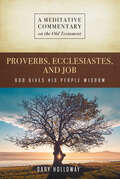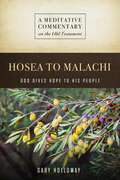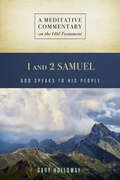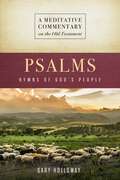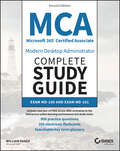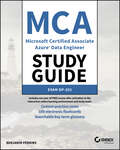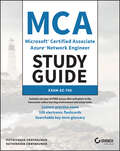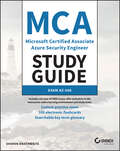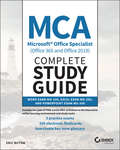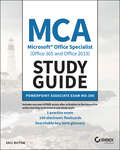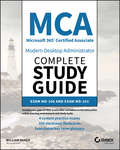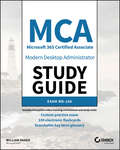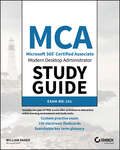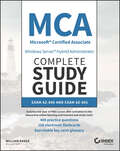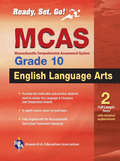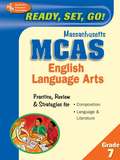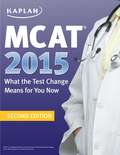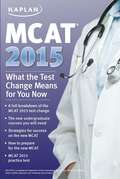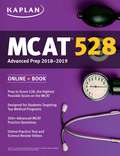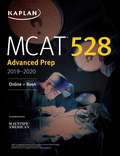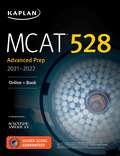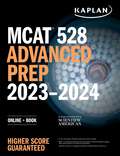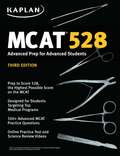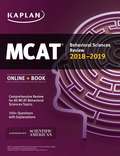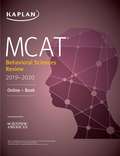- Table View
- List View
MC: God Gives His People Wisdom
by Gary HollowayIn a world bombarded with information, what we long for is knowing how to live well-what the Bible calls wisdom. Meditate on the Wisdom books of the Bible to hear the source of wisdom-the God who made us. In these meditations we will hear the established wisdom passed down from earlier generations. These nuggets of wisdom are found in the book of Proverbs. A proverb is a traditional saying, and as such, proverbs are didactic, optimistic, practical, and conservative. Ecclesiastes contains a different kind of wisdom, built on the wisdom of Proverbs, but which asks what happens when proverbial wisdom fails. Ecclesiastes looks at the mysteries of life. It is reflective, speculative, pessimistic, and creative. It asks the hard questions, like how does life make sense? It explains that often, it doesn't. Plans fail. Fools triumph. We must trust God especially when things don't make sense. That deeper spirituality is put to the test in Job. "The fear of the Lord is the beginning of wisdom." This is a repeated theme in Proverbs. Job experiences a deeper fear of the Lord, one based on trust alone. By meditating on the ordeals of Job, we are brought closer to a God we might not like and do not understand. The only God we have. Meditating on these books will at times be a joy. At other times, meditation will be a challenge. Wisdom does not come easy. But it is a marvelous gift of God.
MC: God Gives Hope to His People
by Gary HollowayThe Lord reigns—through his judgment, righteousness, mercy, and forgiveness. Along with strong warnings of punishment, these twelve prophets give amazing comfort and hope to God’s people. That hope is based on their repentance. These prophets call them to turn to or return to the Lord. No matter what they have done to abandon their allegiance to God, the Lord is still faithful to the covenant. All they must do to receive the abundant blessings God promises is to turn back to him. This turning must be more than words or fasting or sacrifice. They must return to him with their actions. Only by this constant repentance can they truly be God’s people. The Lord reigns. That is the theme that encompasses all the messages of these prophets. It includes God’s judgment, righteousness, mercy, and forgiveness. Because the Lord is King, he demands the exclusive allegiance of his people. As King, he expects his people to reflect his justice and mercy toward their enemies. And he is King not only of Israel and Judah but of the whole earth. The twelve prophets point to a time when the universal reign of the Lord is embraced by every nation and all people.
MC: God Speaks to His People
by Gary Holloway“The word of the Lord was rare in those days.” Is it also rare in ours? Has God abandoned us? He sent his Son Jesus to live and die for us. He raised him from the dead and brought him back to his right hand. But after the ascension of Jesus, has God left us on our own to do the best we can to follow the example of Christ? Or does God still speak today? This study is written with the conviction that God still speaks today. He speaks through the Bible, his Word. He speaks through the lives of faithful Christians. He speaks to us, and we speak to him in prayer. He speaks in all the circumstances of life. Listening to God may be a frightening experience, but it is more dangerous to live our lives without hearing him. Are we listening? When we pray, do we bring our to-do list to God and in essence say, “Listen God, I’ve got stuff for you to do”? Or, like Samuel, do we say, “Speak Lord, your servant is listening.” When we hear the voice of God, are we willing to obey? Or, like Saul, do we listen and follow only when it suits us? Are we, like David, people after God’s own heart? This is an invitation to hear the voice of God in 1 and 2 Samuel. Read it in prayer. Listen to what others around you are hearing. Hear what the Spirit is saying to the churches. Come to this book with a humble heart to hear and to do the Word of the Lord.
MC: Hymns of God's People
by Gary HollowayThe Psalms are the hymnbook of Israel and the church, revealing how we experience the shape of grief, thankfulness, repentance, remembrance, and future hope. We need these words to survive in our world. MC: Psalms: Hymns of God's People is an invitation to hear God's voice in personal daily Bible study as well as in communal readings with fellow believers. Join Dr. Holloway and begin to grow in your ability to meditate on the Psalms. Learn to bring your requests to the heart of God and develop your relationship with Jesus. Allow the Spirit to give language to your cries for justice and concerns about the brokenness of our world.
MCA Microsoft 365 Certified Associate Modern Desktop Administrator Complete Study Guide with 900 Practice Test Questions: Exam MD-100 and Exam MD-101
by William PanekComplete, UPDATED study guide for MCA Modern Desktop Administrator certification exams, MD-100 and MD-101. Covers new Windows 11, services, technologies, and more! MCA Microsoft 365 Certified Associate Modern Desktop Administrator Complete Study Guide, Second Edition, is your all-in-one guide to preparing for the exams that will earn you the MCA Modern Desktop Administrator certification! In this book, well-known Windows guru and five-time Microsoft MVP, William Panek, guides you through the latest versions of the Windows Client exam (MD-100) and the Managing Modern Desktops exam (MD-101). This one-stop resource covers 100% of the objectives for both exams, providing real world scenarios, hands-on exercises, and challenging review questions. You’ll also dive deeper into some of the more complex topics and technologies, including deploying, maintaining, and upgrading Windows; managing devices and data; configuring storage and connectivity; managing apps and data; and more. Learn everything you need to know to pass the MD-100 and MD-101 exams Earn your MCA Modern Desktop Administrator certification to launch or advance your career Access exercises, review questions, flashcards, and practice exams, in the book and online Master all of the test objectives for the latest exam versions—updated for Windows 11With this study guide, you also get access to Sybex’s superior online learning environment, including an assessment test, hundreds of practice exams, flashcards, searchable glossary, and videos for many of the chapter exercises. This is the perfect test prep resource for admins preparing for certification and anyone looking to upgrade their existing skills to Microsoft’s latest desktop client.
MCA Microsoft Certified Associate Azure Data Engineer Study Guide: Exam DP-203
by Benjamin PerkinsPrepare for the Azure Data Engineering certification—and an exciting new career in analytics—with this must-have study aide In the MCA Microsoft Certified Associate Azure Data Engineer Study Guide: Exam DP-203, accomplished data engineer and tech educator Benjamin Perkins delivers a hands-on, practical guide to preparing for the challenging Azure Data Engineer certification and for a new career in an exciting and growing field of tech. In the book, you’ll explore all the objectives covered on the DP-203 exam while learning the job roles and responsibilities of a newly minted Azure data engineer. From integrating, transforming, and consolidating data from various structured and unstructured data systems into a structure that is suitable for building analytics solutions, you’ll get up to speed quickly and efficiently with Sybex’s easy-to-use study aids and tools. This Study Guide also offers: Career-ready advice for anyone hoping to ace their first data engineering job interview and excel in their first day in the field Indispensable tips and tricks to familiarize yourself with the DP-203 exam structure and help reduce test anxiety Complimentary access to Sybex’s expansive online study tools, accessible across multiple devices, and offering access to hundreds of bonus practice questions, electronic flashcards, and a searchable, digital glossary of key terms A one-of-a-kind study aid designed to help you get straight to the crucial material you need to succeed on the exam and on the job, the MCA Microsoft Certified Associate Azure Data Engineer Study Guide: Exam DP-203 belongs on the bookshelves of anyone hoping to increase their data analytics skills, advance their data engineering career with an in-demand certification, or hoping to make a career change into a popular new area of tech.
MCA Microsoft Certified Associate Azure Network Engineer Study Guide: Exam AZ-700
by Puthiyavan Udayakumar Kathiravan UdayakumarPrepare to take the NEW Exam AZ-700 with confidence and launch your career as an Azure Network Engineer Not only does MCA Microsoft Certified Associate Azure Network Engineer Study Guide: Exam AZ-700 help you prepare for your certification exam, it takes a deep dive into the role and responsibilities of an Azure Network Engineer, so you can learn what to expect in your new career. You&’ll also have access to additional online study tools, including hundreds of bonus practice exam questions, electronic flashcards, and a searchable glossary of important terms. Prepare smarter with Sybex's superior interactive online learning environment and test bank. Exam AZ-700, Designing and Implementing Microsoft Azure Networking Solutions, measures your ability to design, implement, manage, secure, and monitor technical tasks such as hybrid networking; core networking infrastructure; routing; networks; and private access to Azure services. With this in-demand certification, you can qualify for jobs as an Azure Network Engineer, where you will work with solution architects, cloud administrators, security engineers, application developers, and DevOps engineers to deliver Azure solutions. This study guide covers 100% of the objectives and all key concepts, including: Design, Implement, and Manage Hybrid Networking Design and Implement Core Networking Infrastructure Design and Implement Routing Secure and Monitor Networks Design and Implement Private Access to Azure Services If you&’re ready to become the go-to person for recommending, planning, and implementing Azure networking solutions, you&’ll need certification with Exam AZ-700. This is your one-stop study guide to feel confident and prepared on test day. Trust the proven Sybex self-study approach to validate your skills and to help you achieve your career goals!
MCA Microsoft Certified Associate Azure Security Engineer Study Guide: Exam AZ-500
by Shimon BrathwaitePrepare for the MCA Azure Security Engineer certification exam faster and smarter with help from Sybex In the MCA Microsoft Certified Associate Azure Security Engineer Study Guide: Exam AZ-500, cybersecurity veteran Shimon Brathwaite walks you through every step you need to take to prepare for the MCA Azure Security Engineer certification exam and a career in Azure cybersecurity. You&’ll find coverage of every domain competency tested by the exam, including identity management and access, platform protection implementation, security operations management, and data and application security. You&’ll learn to maintain the security posture of an Azure environment, implement threat protection, and respond to security incident escalations. Readers will also find: Efficient and accurate coverage of every topic necessary to succeed on the MCA Azure Security Engineer exam Robust discussions of all the skills you need to hit the ground running at your first—or next—Azure cybersecurity job Complementary access to online study tools, including hundreds of bonus practice exam questions, electronic flashcards, and a searchable glossaryThe MCA Azure Security Engineer AZ-500 exam is a challenging barrier to certification. But you can prepare confidently and quickly with this latest expert resource from Sybex. It&’s ideal for anyone preparing for the AZ-500 exam or seeking to step into their next role as an Azure security engineer.
MCA Microsoft Office Specialist (Office 365 and Office 2019) Complete Study Guide: Word Exam MO-100, Excel Exam MO-200, and PowerPoint Exam MO-300
by Eric ButowMaster one of the most essential skill sets for the contemporary office As Microsoft Office becomes ever more ubiquitous in modern offices across the world, competence and familiarity with its intricacies is more important than ever. Now you can set yourself apart from the pack and prove your skills with the Microsoft Office Specialist certification. The MCA Microsoft Office Specialist (Office 365 and Office 2019) Complete Study Guide : Word Associate Exam MO-100, Excel Associate Exam MO-200, and PowerPoint Associate Exam MO-300 delivers a comprehensive roadmap to achieving the certification with easy-to-follow instruction for each of the three required proficiencies: Word, Excel, and PowerPoint. You’ll enjoy access to chapter review questions and Exam Essentials, a feature that identifies critical subject areas. Discover practical, hands-on exercises that prepare you for real-world roles and jobs, and gain valuable experience as you reinforce key Microsoft Office skills that you’ll be expected to demonstrate in job interviews and your day-to-day professional life. Learn to manage and create text documents in Word, perform operations with formulas in Excel, and create engaging slideshows and presentations in PowerPoint. This practical book also provides: Fully updated information for the latest Microsoft Office Specialist certification exams covering Microsoft Office 365 Access to new career opportunities with a professional certification that’s relevant to virtually any office environment Access to the Sybex online study tools, with chapter review questions, full-length practice exams, hundreds of electronic flashcards, and a glossary of key terms The MCA Microsoft Office Specialist (Office 365 and Office 2019) Complete Study Guide offers crystal-clear organization, comprehensive coverage, and easy-to-understand instruction. It’s perfect for anyone who hopes to prove their skills with the Microsoft Office Specialist certification or to improve their mastery of Microsoft Office 365.
MCA Microsoft Office Specialist (Office 365 and Office 2019) Study Guide: PowerPoint Associate Exam MO-300
by Eric ButowMCA Microsoft Office Specialist Study Guide: PowerPoint Associate Exam MO-300 is your roadmap to preparing for taking the MO-300 exam and earning the PowerPoint Associate (PowerPoint and PowerPoint 2019) certification. The following objectives are covered: Manage presentations Manage slides Insert and format text, shapes, and images Insert tables, charts, smartArt, 3D models, and media Apply transitions and animations Major topics include creating, editing, and enhancing presentations and slideshows, including the ability to create and manage presentations, insert and format shapes and slides, create slide content, apply transitions and animations, and manage multiple presentations. This Study Guide also covers creating professional-grade sales presentations, employee training, instructional materials, and kiosk slideshows.Readers will also have access to Sybex's superior online test bank, includng hundreds of practice questions, flashcards, and a glossary of important terms.
MCA Modern Desktop Administrator Complete Study Guide: Exam MD-100 and Exam MD-101
by William PanekThe ultimate study guide for Microsoft 365 Certified Associate (MCA) Modern Desktop certification—covers the new Exam MD-100 and the new Exam MD-101 in one book! Referred to as the Modern Desktop, Microsoft 365 is Microsoft’s new suite of modern workplace services comprising Windows 10, Office 365, and Enterprise Mobility & Security. IT administrators tasked with deploying and implementing Modern Desktop are required to configure, secure, manage, and monitor devices and applications in enterprise environments. Success on the MCA Modern Desktop Administrator certification exam is essential for IT professionals seeking to expand their job opportunities and advance their careers. The MCA Modern Desktop Administrator Complete Study Guide is an indispensable resource for candidates preparing for certification. This guide covers 100% of all exam objectives for the new Exam MD-100: Windows 10 and the new Exam-101: Managing Modern Desktops. All aspects of both new exams are covered, including in-depth information on advanced topics and technologies. Included is access to Sybex's comprehensive online learning environment—offering an assessment test, bonus practice exams, electronic flashcards, a searchable glossary, and videos for many of the chapter exercises. This must-have guide enables users to: Configure devices, core services, networking, storage, users, updates, and system and data recovery Implement, install, maintain, manage, and monitor Windows 10 Plan desktop deployment and Microsoft Intune device management solutions Manage identities, applications, remote access, and data access and protection Review real-world scenarios, hands-on exercises, and challenging practice questions The MCA Modern Desktop Administrator Complete Study Guide: Exam MD-100 and Exam MD-101 is an essential tool for anyone preparing for the exams and students and IT professionals looking to learn new skills or upgrade their existing skills.
MCA Modern Desktop Administrator Study Guide: Exam MD-100
by William PanekThe essential study guide for the new Microsoft 365 Certified Associate (MCA) Modern Desktop certification—covers Exam MD-100: Windows 10! The new Microsoft 365 Certified Associate (MCA) Modern Desktop certification exam measures a candidate’s ability to deploy Windows, manage devices and data, configure connectivity, and maintain Windows. MCA certification, sought by a growing number of employers, is an important part of any IT professional’s resume. The MCA Modern Desktop Administrator Study Guide: Exam MD-100 is a must-have book for anyone preparing for certification. This clear and accurate study guide covers 100% of exam objectives—providing hands-on exercises, challenging review questions, full explanations, and real-world examples. From the intricacies of Windows deployment to advanced security and enterprise capabilities, each chapter explains everything candidates need to know for passing the exam and earning MCA certification. This accurate, up-to-date study guide is designed to prepare administrators to deploy, configure, secure, manage, and monitor devices and client applications in an enterprise environment. Access to Sybex's comprehensive online learning environment—comprising a self-assessment test, a bonus practice exam, flashcards, a searchable glossary, and chapter exercise videos—is included to fully prepare for exam day. This study guide: Covers all Exam: MD-100 objectives Prepares readers to implement, install, and configure Windows 10 Reinforces comprehension and retention of central exam topics Helps readers learn new skills or upgrade existing skills to Microsoft's latest desktop client Demand for competent IT professionals is already high and continues to grow at a rapid pace. The MCA Modern Desktop Administrator Study Guide: Exam MD-100 is a valuable resource for preparing for the new Exam MD-100 and MCA certification.
MCA Modern Desktop Administrator Study Guide: Exam MD-101
by William PanekThe must-have preparation guide for MCA Modern Desktop certification—covers the new Exam MD-101: Managing Modern Desktops! Microsoft’s Modern Desktop integrates Windows 10, Office 365, and advanced security capabilities. Microsoft 365 Certified Associate (MCA) Modern Desktop certification candidates need to be familiar with Microsoft 365 workloads and demonstrate proficiency in deploying, configuring, and maintaining Windows 10 and non-Windows devices and technologies. The new Exam MD-101: Managing Modern Desktops measures candidate’s ability to deploy and update operating systems, manage policies and profiles, manage and protect devices, and manage apps and data. Candidates are required to know how to perform a range of tasks to pass the exam and earn certification. The MCA Modern Desktop Administrator Study Guide: Exam MD-101 provides in-depth examination of the complexities of Microsoft 365. Focusing on the job role of IT administrators, this clear, authoritative guide covers 100% of the new exam objectives. Real-world examples, detailed explanations, practical exercises, and challenging review questions help readers fully prepare for the exam. Sybex's comprehensive online learning environment—in which candidates can access an assessment test, electronic flash cards, a searchable glossary, bonus practice exams, and videos for chapter exercises—is included to provide comprehensive exam preparation. Topics include: Planning and implementing Windows 10 using dynamic deployment and Windows Autopilot Upgrading devices to Windows 10 and managing updates and device authentication Managing access polices, compliance policies, and device and user profiles Implementing and managing Windows Defender and Intune device enrollment Deploying and updating applications and implementing Mobile Application Management (MAM) The move to Windows 10 has greatly increased the demand for qualified and certified desktop administrators in corporate and enterprise settings. MCA Modern Desktop Administrator Study Guide: Exam MD-101: Managing Modern Desktops is an invaluable resource for IT professionals seeking MCA certification.
MCA Windows Server Hybrid Administrator Complete Study Guide with 400 Practice Test Questions: Exam AZ-800 and Exam AZ-801
by William PanekYour 2-exams-in-1 study guide for the next-gen Windows Server 2022 certification In MCA Windows Server Hybrid Administrator Complete Study Guide: Exam AZ-800 and Exam AZ-801, five-time Microsoft MVP and veteran IT trainer William Panek delivers a one-stop resource to help you efficiently prepare for and pass the required exams for Microsoft’s latest Windows Server certification. In the book, you’ll learn to expertly administer Windows Server workloads and services using on-premises, hybrid, and cloud technologies. The book provides hands-on explanations of all relevant Windows Server administration tasks, from security to migration, monitoring, troubleshooting, disaster recovery, and more. You’ll also find: 100% coverage of the objectives of each of the exams required to access an in-demand and lucrative new certification The skills and tools you’ll need to succeed as a newly minted Windows Server 2022 administrator Complimentary access to Sybex’ superior interactive online learning environment and test bank, which offers hundreds of practice questions, flashcards, and a glossaryA practical and indispensable resource for anyone seeking to acquire the brand-new MCA Windows Server Hybrid Administrator certification, MCA Windows Server Hybrid Administrator Complete Study Guide also deserves a place in the libraries of aspiring and practicing network and system administrators looking for an actionable guide to on-premises, hybrid, and cloud Windows Server 2022 environments.
MCAS English Language Arts, Grade 10 (Massachusetts Mcas Test Preparation Ser.)
by J. Brice Dana PassanantiREA … Real review, Real practice, Real results. REA's Massachusetts Grade 10 MCAS English Language Arts Study Guide! Fully aligned with the Learning Standards in the Massachusetts Curriculum Frameworks Are you prepared to excel on this state high-stakes assessment exam? * Required for a high school diploma * Find out what you know and what you should know * Use REA's advice and tips to ready yourself for proper study and practice Sharpen your knowledge and skills * The book's full subject review refreshes knowledge and covers both components on the official exam, Language/Literature and Composition * Smart and friendly lessons reinforce necessary skills * Key tutorials enhance specific abilities needed on the test * Targeted drills increase comprehension and help organize study * Color icons and graphics highlight important concepts and tasks Practice for real * Create the closest experience to test-day conditions with two full-length practice tests * Chart your progress with detailed explanations of each answer * Boost confidence with test-taking strategies and focused drills Ideal for Classroom, Family, or Solo Test Preparation! REA has helped generations of students study smart and excel on the important tests. REA’s study guides for state-required exams are teacher-recommended and written by experts who have mastered the test.
MCAS English Language Arts, Grade 7 (Massachusetts Mcas Test Preparation Ser.)
by Editors of REA Dana PassanantiREA's Massachusetts Grade 7 MCAS English Language Arts Test Prep! Fully aligned with the Massachusetts Curriculum Framework Standards Are you prepared to excel on this state high-stakes assessment exam? * Take the diagnostic Pretest and find out what you know and what you should know * Use REA's advice and tips to ready yourself for proper study and practice Sharpen your knowledge and skills * The book's full subject review refreshes knowledge and covers all topics on the official exam, including Composition and Language and Literature * Smart and friendly lessons reinforce necessary skills * Key tutorials enhance specific abilities needed on the test * Targeted drills increase comprehension and help organize study * Color icons and graphics highlight important concepts and tasks Practice for real * Create the closest experience to test-day conditions with a full-length practice Posttest * Chart your progress with detailed explanations of each answer * Boost confidence with test-taking strategies and focused drills Ideal for Classroom, Family, or Solo Test Preparation! REA has helped generations of students study smart and excel on the important tests. REA's study guides for state-required exams are teacher-recommended and written by experts who have mastered the test.
MCAT 2015: What the Test Change Means for You Now
by KaplanBig changes are coming to the MCAT in 2015, and Kaplan is here to help you prepare for them.With four brand-new sections, 80% more questions, and the addition of new science content including biochemistry, psychology, and sociology, the 2015 MCAT will be a completely different test. In order to be prepared you need to understand the exam and start planning for it now, and this guide is the first step.MCAT 2015: What the Test Change Means for You Now is your complete guide to the new exam, with outlines of both old and new subject areas, a short-form practice test to help you get ready, and advice on choosing and prepping for the MCAT thatâ TMs right for you.
MCAT 2015: What the Test Change Means for You Now
by Kaplan Publishing StaffBig changes are coming to the MCAT in 2015, and Kaplan is here to help you prepare for them. With four brand-new sections, 80% more questions, and the addition of new science content including biochemistry, psychology, and sociology, the 2015 MCAT will be a completely different test. In order to be prepared you need to understand the exam and start planning for it now, and this guide is the first step. MCAT 2015: What the Test Change Means for You Now is your complete guide to the new exam, with outlines of both old and new subject areas, a short-form practice test to help you get ready, and advice on choosing and prepping for the MCAT that's right for you.
MCAT 528 Advanced Prep 2018-2019: Online + Book
by Kaplan Test PrepKaplan's MCAT 528 Advanced Prep 2018-2019 features thorough subject review, more questions than any competitor, and the highest-yield questions available – all authored by the experts behind the MCAT prep course that has helped more people get into medical school than all other major courses combined.Prepping for the MCAT is a true challenge. Kaplan can be your partner along the way – offering guidance on where to focus your efforts, how to organize your review, and targeted focus on the most-tested concepts. This edition features commentary and instruction from Kaplan's MCAT experts and has been updated to match the AAMC's guidelines precisely—no more worrying if your MCAT review is comprehensive!The Most PracticeMore than 500 questions in the book and access to even more online – more practice than any other advanced MCAT book on the market.The Best PracticeComprehensive subject review is written by top-rated, award-winning Kaplan instructors.All material is vetted by editors with advanced science degrees and by a medical doctor.Online resources help you master the computer-based format you'll see on Test Day.Expert GuidanceStar-Ratings throughout the book indicate how important each topic will be to your score on the real exam—informed by Kaplan's decades of MCAT experience and facts straight from the testmaker.We know the test: The Kaplan MCAT team has spent years studying every MCAT-related document available.Kaplan's expert psychometricians ensure our practice questions and study materials are true to the test.
MCAT 528 Advanced Prep 2019-2020: Online + Book (Kaplan Test Prep)
by Kaplan Test PrepKaplan's MCAT 528 Advanced Prep 2019-2020 features thorough subject review, more questions than any competitor, and the highest-yield questions available – all authored by the experts behind the MCAT prep course that has helped more people get into medical school than all other major courses combined.Prepping for the MCAT is a true challenge. Kaplan can be your partner along the way – offering guidance on where to focus your efforts, how to organize your review, and targeted focus on the most-tested concepts. This edition features commentary and instruction from Kaplan's MCAT experts and has been updated to match the AAMC's guidelines precisely—no more worrying if your MCAT review is comprehensive!The Most PracticeMore than 500 questions in the book and access to even more online – more practice than any other advanced MCAT book on the market.The Best PracticeComprehensive subject review is written by top-rated, award-winning Kaplan instructors.All material is vetted by editors with advanced science degrees and by a medical doctor.Online resources, including a full-length practice test, help you master the computer-based format you'll see on Test Day.Expert GuidanceStar-Ratings throughout the book indicate how important each topic will be to your score on the real exam—informed by Kaplan's decades of MCAT experience and facts straight from the testmaker.We know the test: The Kaplan MCAT team has spent years studying every MCAT-related document available.Kaplan's expert psychometricians ensure our practice questions and study materials are true to the test.
MCAT 528 Advanced Prep 2021â€"2022: Online + Book (Kaplan Test Prep)
by Kaplan Test PrepKaplan's MCAT 528 Advanced Prep 2021–2022 features thorough subject review, more questions than any competitor, and the highest-yield questions available—all authored by the experts behind the MCAT prep course that has helped more people get into medical school than all other major courses combined.Prepping for the MCAT is a true challenge. Kaplan can be your partner along the way—offering guidance on where to focus your efforts, how to organize your review, and targeted focus on the most-tested concepts. This edition features commentary and instruction from Kaplan's MCAT experts and has been updated to match the AAMC's guidelines precisely—no more worrying if your MCAT review is comprehensive!The Most PracticeMore than 500 questions in the book and access to even more online—more practice than any other advanced MCAT book on the market.The Best PracticeComprehensive subject review is written by top-rated, award-winning Kaplan instructors.All material is vetted by editors with advanced science degrees and by a medical doctor.Online resources, including a full-length practice test, help you master the computer-based format you'll see on Test Day.Expert GuidanceStar Ratings throughout the book indicate how important each topic will be to your score on the real exam—informed by Kaplan's decades of MCAT experience and facts straight from the testmaker.We know the test: The Kaplan MCAT team has spent years studying every MCAT-related document available.Kaplan's expert psychometricians ensure our practice questions and study materials are true to the test.
MCAT 528 Advanced Prep 2023-2024: Online + Book (Kaplan Test Prep)
by Kaplan Test PrepKaplan's MCAT 528 Advanced Prep 2023–2024 features thorough subject review, more questions than any competitor, and the highest-yield questions available—all authored by the experts behind the MCAT prep course that has helped more people get into medical school than all other major courses combined.Prepping for the MCAT is a true challenge. Kaplan can be your partner along the way—offering guidance on where to focus your efforts, how to organize your review, and targeted focus on the most-tested concepts. This edition features commentary and instruction from Kaplan's MCAT experts and has been updated to match the AAMC's guidelines precisely—no more worrying if your MCAT review is comprehensive!The Most PracticeMore than 500 questions in the book and online and access to even more online—more practice than any other advanced MCAT book on the market.The Best PracticeComprehensive subject review is written by top-rated, award-winning Kaplan instructors.All material is vetted by editors with advanced science degrees and by a medical doctor.Online resources, including a full-length practice test, help you master the computer-based format you'll see on Test Day.Expert GuidanceStar Ratings throughout the book indicate how important each topic will be to your score on the real exam—informed by Kaplan's decades of MCAT experience and facts straight from the testmaker.We know the test: The Kaplan MCAT team has spent years studying every MCAT-related document available.Kaplan's expert psychometricians ensure our practice questions and study materials are true to the test.
MCAT 528: Advanced Prep for Advanced Students
by KaplanMore people get into medical school with a Kaplan MCAT course than all major courses combined. Now the same results are available with Kaplan's MCAT 528. This book features thorough subject review, more questions than any competitor, and the highest-yield questions available. The commentary and instruction come directly from Kaplan MCAT experts and include targeted focus on the most-tested concepts.MCAT 528 offers:UNPARALLELED MCAT KNOWLEDGE: The Kaplan MCAT team has spent years studying every MCAT-related document available. In conjunction with our expert psychometricians, the Kaplan team is able to ensure the accuracy and realism of our practice materials.THOROUGH SUBJECT REVIEW: Written by top-rated, award-winning Kaplan instructors, all material has been vetted by editors with advanced science degrees and by a medical doctor.EXPANDED CONTENT THROUGHOUT: As the MCAT has continued to develop, this book has been updated continuously to match the AAMC's guidelines precisely--no more worrying if your prep is comprehensive!"STAR RATINGS" FOR EVERY SUBJECT: New for the 3rd Edition of MCAT 528, every topic is assigned a "star rating"--informed by Kaplan's decades of MCAT experience and facts straight from the testmaker--of how important it will be to your score on the real exam.MORE PRACTICE THAN THE COMPETITION: With 500+ questions throughout the book and access to a full-length practice test online, MCAT 528 has more practice than any other advanced MCAT book on the market.ONLINE COMPANION: One practice test and additional online resources help augment content studying. The MCAT is a computer-based test, so practicing in the same format as Test Day is key.KAPLAN'S MCAT REPUTATION: Kaplan is a leader in the MCAT prep market, and twice as many doctors prepared for the MCAT with Kaplan than with any other course.*UTILITY:MCAT 528 can be used alone or with the other companion books in Kaplan's MCAT Review series. * Doctors refers to US MDs who were licensed between 2001-2010 and used a fee-based course to prepare for the MCAT. The AlphaDetail, Inc. online study for Kaplan was conducted between Nov. 10 - Dec. 9, 2010 among 763 US licensed MDs, of whom 462 took the MCAT and used a fee-based course to prepare for it.
MCAT Behavioral Sciences Review 2018-2019: Online + Book
by Kaplan Test PrepKaplan's MCAT Behavioral Sciences Review offers an expert study plan, detailed subject review, and hundreds of online and in-book practice questions – all authored by the experts behind the MCAT prep course that has helped more people get into medical school than all other major courses combined.Prepping for the MCAT is a true challenge. Kaplan can be your partner along the way – offering guidance on where to focus your efforts and how to organize your review. This book has been updated to match the AAMC's guidelines precisely—no more worrying if your MCAT review is comprehensive!The Most PracticeMore than 350 questions in the book and access to even more online – more practice than any other MCAT behavioral sciences book on the market.The Best PracticeComprehensive behavioral sciences subject review is written by top-rated, award-winning Kaplan instructors.Full-color, 3-D illustrations from Scientific American, charts, graphs and diagrams help turn even the most complex science into easy-to-visualize concepts.All material is vetted by editors with advanced science degrees and by a medical doctor.Online resources help you practice in the same computer-based format you'll see on Test Day.Expert GuidanceHigh-yield badges throughout the book identify the top 100 topics most-tested by the AAMC.We know the test: The Kaplan MCAT team has spent years studying every MCAT-related document available.Kaplan's expert psychometricians ensure our practice questions and study materials are true to the test.
MCAT Behavioral Sciences Review 2019-2020: Online + Book (Kaplan Test Prep)
by Kaplan Test PrepA Simon & Schuster eBook. Simon & Schuster has a great book for every reader.
